RECOMMENDED
A talented young cast and some imaginative directorial touches highlight Spring Awakening at Santa Monica’s Morgan-Wixson, a laudably bold programming choice for the venerable Westside community theater despite certain deficiencies in design, particularly sound, that prevent the Steven Sater/Duncan Sheik musical from being an unqualified success.
Like Frank Wedenkind’s 1891 German-language drama Frühlings Erwachen on which it is based, 2006’s Spring Awakening breaks plenty of musical theater ground with its depiction of on-and/or-offstage masturbation, child abuse, bondage, rape, abortion, and suicide among 14-year-olds just now awakening to their sexuality. (With so much to shock audiences of yesteryear, it’s no wonder Wedenkind’s late nineteenth-century shocker wasn’t staged on Broadway until 1916 and ended up closing after a single performance.)
Fortunately, Sater and Sheik’s musical has proved considerably more successful than its source material, running nearly 900 performances on the Great White Way, winning eight Tonys including Best Musical, Book, and Score, and engendering two National Tours.
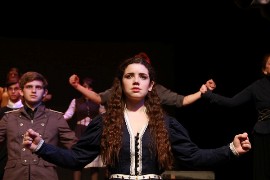 Spring Awakening (The Musical) follows Wedekind’s storylines, though not to the letter. There are its two teen heroes, the handsome, popular, self-confident Melchior (Julian Comeau) and his introverted, inhibited, wet-dream-plagued classmate Moritz (Zach Zagoria), and its heroine, the all-too-innocent but no less sexually inquisitive girl-next-door Wendla (Quinn D’Andrea). There are also Melchior and Moritz’s ever-horny classmates and Wendla’s equally randy girlfriends. A pair of more seasoned actors (Joanna Churgin and Matt Harrison) stand in for all the adults in these teens’ lives.
Spring Awakening (The Musical) follows Wedekind’s storylines, though not to the letter. There are its two teen heroes, the handsome, popular, self-confident Melchior (Julian Comeau) and his introverted, inhibited, wet-dream-plagued classmate Moritz (Zach Zagoria), and its heroine, the all-too-innocent but no less sexually inquisitive girl-next-door Wendla (Quinn D’Andrea). There are also Melchior and Moritz’s ever-horny classmates and Wendla’s equally randy girlfriends. A pair of more seasoned actors (Joanna Churgin and Matt Harrison) stand in for all the adults in these teens’ lives.
What made Spring Awakening work so brilliantly on Broadway was not just Sater’s streamlining of Wedekind’s melodramatic plot threads; singer-songwriter-pop star Sheik’s catchy alternative rock score, the likes of which has probably never before been heard on a Broadway stage, and Bill T. Jones’ brilliantly innovative choreography together turned Spring Awakening into a mainstream (and cult) international phenomenon.
For this reviewer, the magic in Spring Awakening has always begun when the mikes (or mics, if you prefer) come out. The show begins quietly, with sexually burgeoning Wendla wondering if she’ll ever be told the truth about man-woman relations in “Mama Who Bore Me,” followed by a very funny sequence in which her highly embarrassed mother avoids the question entirely, an omission which proves ultimately disastrous. The song takes on a rock beat as Wendla’s girlfriends join her in a reprise, mikes in hand, but it’s a bit later that the hand-mikes begin to take on a life of their own.
Melchior and Moritz are in Latin class, the former attempting to rescue the latter from the ire of their monster of a teacher, when the burning need to express what’s going on inside their minds and bodies suddenly erupts. As the first chords of “The Bitch Of Living” sound, Melchior draws from within his school uniform a previously-hidden mike, a gesture so defiant—and unexpected—that the first time I saw it I became a Spring Awakening fan for life.
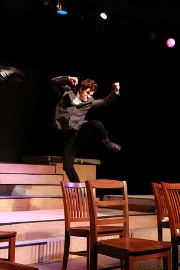 Inspired by Jones’ Tony-winning choreography, the Morgan-Wixson’s Lauren Blair gives us her own vision of the innovative stomps and back kicks and leaps and jumps that characterized Jones’ cutting-edge dances. It’s as if every adolescent urge just bursting to break free now finds itself expressed in dance. The most striking illustration of this comes in Act Two’s “Totally Fucked,” which has the entire cast contorting as if their sexual wants and their dissatisfaction with the world around them were ants crawling all over their bodies and driving them insane with pent-up desire, anger, and frustration.
Inspired by Jones’ Tony-winning choreography, the Morgan-Wixson’s Lauren Blair gives us her own vision of the innovative stomps and back kicks and leaps and jumps that characterized Jones’ cutting-edge dances. It’s as if every adolescent urge just bursting to break free now finds itself expressed in dance. The most striking illustration of this comes in Act Two’s “Totally Fucked,” which has the entire cast contorting as if their sexual wants and their dissatisfaction with the world around them were ants crawling all over their bodies and driving them insane with pent-up desire, anger, and frustration.
Spring Awakening works equally well in its quieter moments, which feature some of Sheik and lyricist Sater’s most memorable compositions. The Pink Floyd-esque “Touch Me,” in which the youthful cast of characters express their desire for intimate physical contact; the anthem-like “I Believe,” which sets the stage for Melchior and Wendla’s sexual flowering; and the exquisitely sad “Left Behind,” sung at a funeral for one of these teens are just three among many such songs.
Without these musical numbers, Spring Awakening would simply be an abbreviated version of Wedekind’s play, albeit skillfully abridged by book-writer Sater. With them, it becomes something out of the ordinary, a music in which contemporary alternative rock makes the struggles of nineteenth-century adolescents seem every bit as relevant to today’s teens as the ones they face on a daily basis, as if twenty-first century souls were inhabiting these long-deceased youths. Melchior, Wendla, and Moritz may have been born in the 1870s, but their dilemmas (like the consequences of Wendla’s insufficient sexual education) still ring true in 2014.
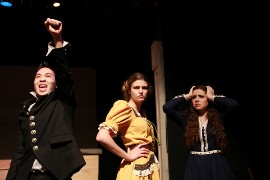 Director Aric Martin, who had only recently graduated from the prestigious Juilliard School Of Drama when Spring Awakening opened on Broadway, brings quite a few inspired directorial and casting choices to the Morgan-Wixson production.
Director Aric Martin, who had only recently graduated from the prestigious Juilliard School Of Drama when Spring Awakening opened on Broadway, brings quite a few inspired directorial and casting choices to the Morgan-Wixson production.
Martin may be taking a chance by casting a pair of seventeen-year-olds as Melchior and Wendla (doubtless the main reason that there is not even a flash of nudity in this production), but his confidence is rewarded by both Comeau and D’Andrea. The latter brings the freshness of youth and some glorious pipes to Wendla, while rising star Comeau gives Melchior a purity that earns audience sympathy throughout, and as Simi Valley audiences have discovered, this stardom-bound teen can vocalize with the best of them.
Just as Comeau’s boy-next-door Melchior plays against pop-star type, so too a terrific Zagoria gives us a Moritz who is less “weirdo” and more misunderstood poet, in addition to showing off rocker pipes in “Don’t Do Sadness” and Twilight-ready looks sure to set hearts a-flutter.
Supporting the three leads are more than a dozen young triple threats, beginning with Scenie winner Aliya Stuart as Ilse, thrown out of a hellish home but steadfastly refusing to “Do Sadness,” and Kaitlyn Fajilan, who shows off rock star vocals as abuse victim/survivor Martha in the haunting “The Dark I Know Well.” Annie Claire Hudson (Anna) and Hunter Larsen (Thea) complete Wendla’s circle of female friends with great big voices and youthful flair, with ensemble members Melissa Deni and Kira Lindsay providing topnotch support.
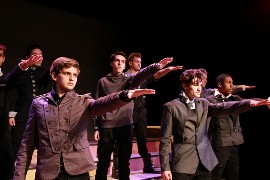 Doing fine work as well are Andrew Mackin as piano teacher-obsessed Georg, Justin Yu as mother-fixated Otto, and ensemble males Tommie Russell and Christian Soto.
Doing fine work as well are Andrew Mackin as piano teacher-obsessed Georg, Justin Yu as mother-fixated Otto, and ensemble males Tommie Russell and Christian Soto.
Best of all are Corey Affron (Hanschen) and Frankie Rodriguez (Ernst), who not only give three dimensions to a pair of stock gay characters but play the former’s seduction of a very willing Ernst not just for laughs, but as an authentic display of young love just beginning to bloom. (Kudos to the Morgan-Wixson for not softening the duo’s passionate boy-boy kissing to make the couple more palatable to older or more conservative audience members.)
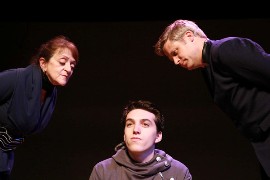 The show’s gamut of adult roles go to Southland community theater treasure Churgin and the TV-star handsome Harrison. Churgin gives us three different mothers and an especially frisky piano teacher, while Harrison gets to play four fathers, a priest, an MD, and an abortionist. Both are at their funniest as the amusingly named Fraulein Knuppeldick and Herr Knochenbruch, high school administrators who vow to make Moritz’s life a living hell.
The show’s gamut of adult roles go to Southland community theater treasure Churgin and the TV-star handsome Harrison. Churgin gives us three different mothers and an especially frisky piano teacher, while Harrison gets to play four fathers, a priest, an MD, and an abortionist. Both are at their funniest as the amusingly named Fraulein Knuppeldick and Herr Knochenbruch, high school administrators who vow to make Moritz’s life a living hell.
Costume designer Kristie Rutledge blends past and present in an especially fine bevy of outfits for her youthful cast (I loved Melchior’s 19th-century hoodie) and subtly tweaked ensembles to distinguish between Churgin’s and Harrison’s multiple adult figures.
Other design elements fall short, however.
Scenic designer Tom Brown’s dull set (a couple of gothic towers on either side of a mostly bare stage) lacks the old-meets-new pizzazz Spring Awakening deserves. Lighting designer William Wilday makes the most of what the Morgan-Wixson has to offer, but this is a show that needs visual fireworks to match the performances on stage and not just color shifts.
Most detrimental of all is the production’s sound design, though again designer Bob Marino does his best with what’s available. That being said, a rock musical like Spring Awakening (or Rock of Ages or American Idiot to name two of its Broadway successors) needs a rock concert-ready soundtrack, and that means amped voices and live (or at least live-sounding) instrumentals with the volume turned up, if not at ear-splitting levels, then at least louder and fuller and with more pulsating bass than the Morgan-Wixson sound system can provide.
Fortunately musical director Anne Gesling is blessed with a cast whose power pipes, particularly in group numbers, goes a good ways in making up for sound design shortcomings and prerecorded instrumental tracks.
Additional credits go to producer W. Joseph Anderson, production stage manager Alycia Perez, prop designer Meredith Wright, light board operator Benjamin Barzalai, sound board operator Chander David, and booth swing Amanda Meade-Tatum.
Though not at the level of previous Morgan-Wixson musical Scenie winners Chicago, The 25th Annual Putnam County Spelling Bee, and Urinetown, Spring Awakening nonetheless serves as a showcase for its terrifically talented young cast, a number of whom may well be headed for stardom, and that alone is reason enough to give this production the look-see it for the most part deserves.
Morgan-Wixson Theatre, 2627 Pico Boulevard, Santa Monica.
www.Morgan-Wixson.org
–Steven Stanley
March 8, 2014
Photos: Joel Castro
Tags: Duncan ShEIk, Los Angeles Theater Review, Morgan-Wixson Theatre, Steven Sater


 Since 2007, Steven Stanley's StageSceneLA.com has spotlighted the best in Southern California theater via reviews, interviews, and its annual StageSceneLA Scenies.
Since 2007, Steven Stanley's StageSceneLA.com has spotlighted the best in Southern California theater via reviews, interviews, and its annual StageSceneLA Scenies.







 COPYRIGHT 2024 STEVEN STANLEY :: DESIGN BY
COPYRIGHT 2024 STEVEN STANLEY :: DESIGN BY